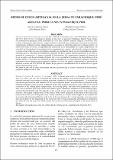Por favor, use este identificador para citar o enlazar este ítem:
https://hdl.handle.net/20.500.12958/3526| Título : | Redes de cerco artesanal en la zona de Parachique, Perú |
| Otros títulos : | Artisanal purse seines in Parachique, Peru |
| Autor : | Ganoza Chozo, Francisco Cornejo Urbina, Rodolfo Alarcón Vélez, Julio Salazar Céspedes, Carlos Martín |
| Palabras clave : | Pesca artesanal;Redes de cerco;Pesquería pelágica;Anchoveta |
| Fecha de publicación : | mar-2021 |
| Editorial : | Instituto del Mar del Perú |
| Citación : | Inf Inst Mar Perú 48(1), 2021, p.103-114 |
| Citación : | Informe IMARPE;48(1), 2021 |
| Resumen : | El estudio se efectuó en las zonas de pesca de Parachique, Región Piura a bordo
de embarcaciones pesqueras (E/P) artesanales de cerco para consumo humano dirigido a anchoveta. Para
evaluar el desempeño operacional y comportamiento de la red de cerco anchovetera artesanal, se realizaron
experimentos mediante sensores batiquimógrafos, colocados en diferentes partes de la relinga inferior y al
centro del cuerpo de la red, se registraron las variaciones de la profundidad de velado, temperatura y la
velocidad de hundimiento. Los parámetros de comportamiento, como la velocidad de caída en el cabecero
y cuerpo de las redes, los que presentaron estimados de correlación buena con la profundidad de calado,
indicando que la velocidad de hundimiento depende del peso, diseño, tamaño, geometría de la malla y
material de construcción. La mayor velocidad de hundimiento del cuerpo central respecto al cabecero de
la red, se debe a que la parte inferior del paño del cerco está totalmente estirado, por efecto del peso de la
relinga inferior y accesorios. Se determinó la baja selectividad de esta red porque las aberturas verticales
presentaron mayor abertura (parte superior e inferior) al inicio del gareteo, reduciéndose el porcentaje de
abertura a menos del 50% al final del gareteo lo que generó el amallamiento de la anchoveta en la parte
inferior del cuerpo de la red. ABSTRACT: We conducted the study in the fishing areas of Parachique, Piura Region, onboard artisanal purse seiners catching anchoveta directed for human consumption. To evaluate the operational performance and behavior of the artisanal purse seines, we performed experiments using bathythermograph sensors, placed in different parts of the leadline and central body of the net, to record variations in the setting depth, temperature, and sinking speed. The behavioral parameters, such as sink rate in the bunt and body of the nets, showed good correlation estimates with the setting depth, which indicated that the sink rate depends on the weight, design, size, mesh geometry, and construction material. The higher sinking speed of the central body when compared to the bunt of the net occurs because the lower part of the purse seine is fully stretched, as a result of the weight of the leadline and accessories. We determined the low selectivity of this net because the vertical openings were more open (top and bottom) at the beginning of the purse line recovering, reducing the percentage of opening to less than 50% by the end of it, which caused the anchoveta to become entangled in the lower body of the net. |
| URI : | https://hdl.handle.net/20.500.12958/3526 |
| ISSN : | 0378-7702 |
| Aparece en las colecciones: | Informe vol. 48(1) 2021 |
Ficheros en este ítem:
| Fichero | Descripción | Tamaño | Formato | |
|---|---|---|---|---|
| Informe 48-1 Articulo13.pdf | 8,09 MB | Adobe PDF |  Visualizar/Abrir |
Este ítem está sujeto a una licencia Creative Commons Licencia Creative Commons

